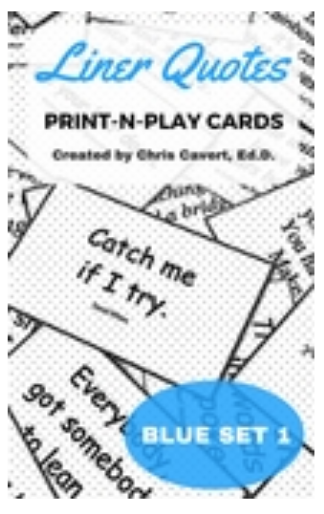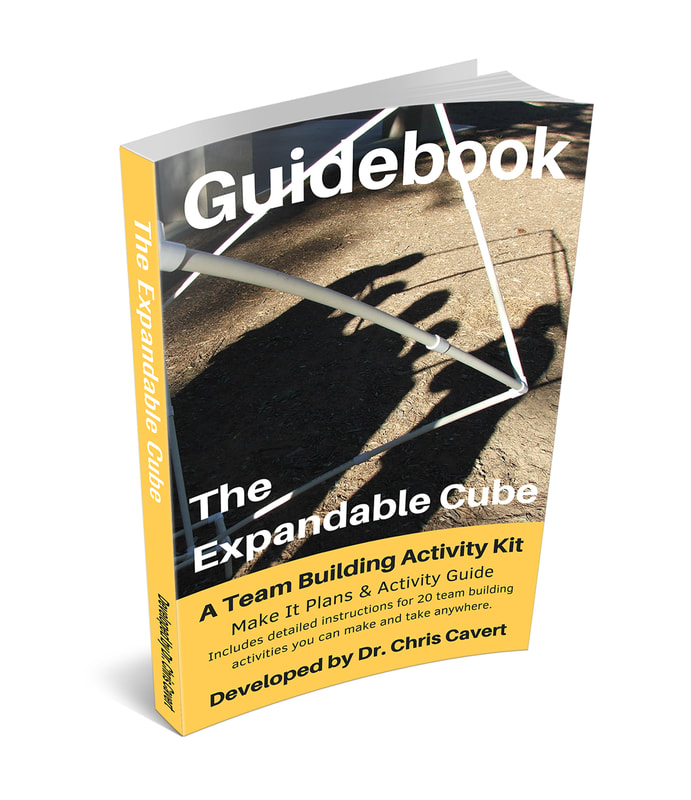Not In the Cards will probably play well with 8 to 12 participants (so far, this one is just an idea). Using a 50-foot activity rope (about that length), set down a square or circle (or whatever shape you want, really) and put out a game spots, one for each participant, around the outside of the shape - set the spots six feet apart from each other (or whatever your distancing LOPs require). (The Set Up above is for 12 participants.)
Setting out 48 Cards: In the picture above, I've set out 48 cards so there are a bunch overlapping - this could be a more challenging set up? An easier array (?) would be to not overlap any cards. Before laying down the cards, take out one card from each suit and set them aside - you'll need to do some prep with these four cards in a moment. If you plan to overlap, be sure to leave enough of each card showing so the rank and suit can be identified.
The other 4 Cards: The four cards you removed from the deck are needed for the second half of the challenge ahead. You need to come up with four mathematical formulas with these numbers that result in (the sums are) different numbers - keep these formulas with you during the activity. For example, say you pulled out a 3, 5, 8 & 10. One number you could use is 26 - if you add the four numbers together. Now, you need three other formulas with these same four numbers. Your others could be: 72, 13 & 10 (Challenge: Find the formulas I used to get these numbers?) (This part of the challenge was inspired by the activity, Get 20, from Playing with a Full Deck by Michelle Cummings.)
Before you can play, you'll need some paper and and markers (you could also use four small white boards and appropriate markers for these). If you have access to clip boards, grab four of those as well. Take four pieces of paper and the four 'sum' numbers you have figured (using the four cards you removed from the deck). Write one number on each piece of paper - a different number on each piece. (Using the example numbers above, one piece of paper will have the number 26, another piece will have 72, another 13, and the fourth piece of paper will have a 10.) Place theses papers nearby, separated from each other, along with a marker (recently sterilized) for each piece of paper. (Make sure you are following your safety protocols for using equipment/supples - if needed.)
- Gather your group around to give them the directions. Be sure you are not too close to the cards/spots set up - you don't want the group to see the cards just yet.
- Tell them there are two parts to the challenge. The first part is to identify the cards that are missing from the pool of cards. [Optional: You can tell them how many are missing, or you can leave this out - leaving this fact out can create other great things to discuss.]
- While working to identify the missing cards, participants must be standing on their own game spot - the spots may not be moved and no one is allowed inside the rope shape.
- When the group has identified all of the missing cards they can ask you for access to the four 'math problems' - this is the second part of the challenge.
- Before accessing the math problems (the four pieces of paper and markers), the group (along with your guidance) will need to decide how they will safely retrieve and use the supplies as a group.
- For the second challenge, the group will need to come up with a mathematical formula that will equal the number on each page, using the numbers on the cards that they determined are missing from the pool. (NOTE: The group might find others ways, than yours, to 'solve' for the number. This is okay. Keep your formulas handy in case you need to provide proof of a formula.)
- When the group understands the two-part challenge, tell them, "When everyone is ready, you can go over to the activity set up and begin."
To reiterate, this activity is still conceptual in nature - no play data yet. So, help me think through this. One of the main facilitated objectives for this activity is to see how the group manages to work through the challenges while safely distancing (based on what you have set up with the group about this). These are some of the questions I'm thinking I could ask a group about this experience:
- Was 'everyone' ready before you went over to the game area? How did you know if everyone was ready?
- Did any planning take place before you started or did you 'jump' right in? What are your thoughts about this?
- What role or responsibility did you have for the first part of the challenge? Did anyone not have a role or responsibility? How did this happen? What are your thoughts about this situation?
- What was your 'process' for discovering the missing cards? Or, was it something other than a process? How did it work out?
- Did you discover all the missing cards? Did you discover too many missing cards? Not enough? Did you have a plan for 'checking' your findings? If so, how did the plan work out? If you did not have a plan, would you consider anything else the next time you are tasked to do something similar?
- How did your 'safety' planning go before you obtained the math problems? What was good about it? What could have been better?
- If you are willing to share, what is your take on the second part of the challenge - solving the math problems. What worked for you? What did not work for you?
- Did you feel like you contributed to the process of solving the math problems? What part did you play? If you didn't feel you helped in any way, what prevented you from helping? Could you have done anything differently?
- How successful were you as a group in solving the challenges - gold, silver or bronze medal? If you didn't get the gold, what was missing? The team that did win the gold, what did they do differently than you?
- If you were to make a bumper sticker that said something about this experience, what would it say? (Remember, there is not a lot of room on a bumper sticker.)
- The size of the cards can change the experience.
- (Reminder) The spacing of the cards can change the experience.
- The size of the rope shape (and the shape) can change the experience.
- The number of cards you remove from the deck can vary - maybe only three or maybe six. Maybe from only one or two suits?
- Assigning participants to roles can influence dynamics. For example: Assign four 'quiet' people to have and write on the paper; Assign two leaders to 'lead' the first challenge, two different people for the safety transition and then two others for the second part of the challenge.
All the best!
Chris Cavert, Ed.D.







 RSS Feed
RSS Feed